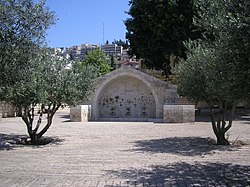This is an old revision of this page, as edited by 67.177.56.158 (talk) at 04:11, 17 July 2005. The present address (URL) is a permanent link to this revision, which may differ significantly from the current revision.
Revision as of 04:11, 17 July 2005 by 67.177.56.158 (talk)(diff) ← Previous revision | Latest revision (diff) | Newer revision → (diff)You must add a |reason= parameter to this Cleanup template – replace it with {{Cleanup|reason=<Fill reason here>}}, or remove the Cleanup template.
- This is about the Middle East city of Nazareth. For other uses, see Nazareth (disambiguation).
Nazareth (Arabic الناصرة an-Nāṣirah; Hebrew נָצְרַת, Standard Hebrew Náẓərat, Tiberian Hebrew Nāṣəraṯ) is an ancient town in Northern Israel. It is the capital of the North District of the country, and the largest Arab city in Israel.

The town is not mentioned in the Old Testament, nor in Josephus nor in the Talmud, and there are no indications that it was settled during prehistoric times. During the Biblical period Japhia was the important town of the area and attracted all the notice of historians, whereas the area that would become the village of Nazareth around the second century was used as a graveyard or burial area. No remains of habitations contemporary with Jesus have turned up, though excavations in 1955 revealed pre-Christian human remains, which would have made the immediate area uninhabitable to observant Jews. In 1961 a Hebrew inscription found in Caesarea mentions Nazareth as one of the villages in which the priestly divisions were residing after the Jewish revolt. It was a satellite village of Sepphoris, 6.5 km. (4 miles) away, and had a population in the 1st century of about 500.
The etymology of Nazareth is not secure; Easton's Bible Dictionary 1897 derives Nazareth from separated, making it a Greek form of the Hebrew netser, a "shoot" or "sprout" but offering the alternative from the Hebrew notserah, i.e., one guarding or watching, thus designating the hill which overlooks and thus guards an extensive region and noting the hill "from which one of the finest prospects in Palestine is obtained."
It is evident from John i. 46 that Nazareth was an obscure place; it was assumed in Judaea that 'nothing good' could possibly come out of the Graeco-Jewish area of Galilee. Epiphanius, who died in 402, says (Adversus Hæreses" i. 136) that until the time of Constantine (4th century), Nazareth was inhabited only by Jews, which seems to imply that in his own day some Christians lived there. In the 6th century, legends about Mary began to spark pilgrim interest in the site, founding the Church of the Annunciation and associating a well with Mary.
According to the New Testament Nazareth was the home of Joseph and Mary and the site of the Annunciation, when Mary was told that she would bear the son of God. Nazareth is also assumed to be where Jesus grew up from his infancy to manhood. However, some historians have called this into question, suggesting instead that it is based on a mistranslation of Greek sources. Such historians argue that Iesou Nazarene was not "from Nazareth", but rather that his title was "Nazarene."
Nazareth is situated among the southern ridges of the Lebanon Mountains, on the steep slope of a hill, about 14 miles from the Sea of Galilee and about 6 west from Mount Tabor. The modern city lies lower down upon the hill than the ancient one. The main road for traffic between Egypt and the interior of Asia passed by Nazareth near the foot of Tabor, and thence northward to Damascus. It has a population of 60,000.
The majority of Nazarenes are Israeli Arabs, about 35-40% of whom are Christians and the rest Muslims. The Israeli government built a new city since the 1950s called Natzrat Illit (נצרת עילית "Upper Nazareth", Standard Hebrew Náẓərat ʿIllit) and populated it with a Jewish majority.
Public representatives in Nazareth have frequently complained about treatment of the town by the Israeli government, which they ascribe to government prejudice against its Arab population. In recent years, there has also been considerable controversy over plans to build a large mosque beside the Basilica of the Annunciation.
External links
- The History of the Ancient Near East
- Nazareth City Website
- Jewish Encyclopedia: Nazareth
- www.jesusneverexisted.com "Nazareth: the town that theology built": a highly critical view of archaeology at Nazareth.
- Easton's Bible Dictionary 1897: Nazareth
- W.R.F. Browning, Oxford Dictionary of the Bible: Nazareth
- Nazareth Village: A model villiage and vistors center.
- Nazareth Sacred Destinations